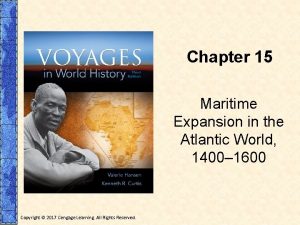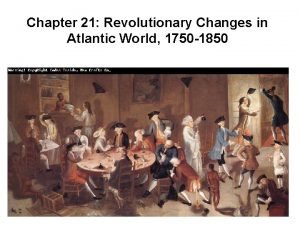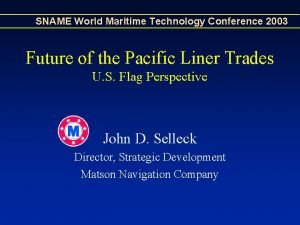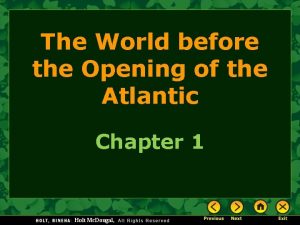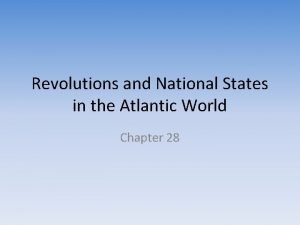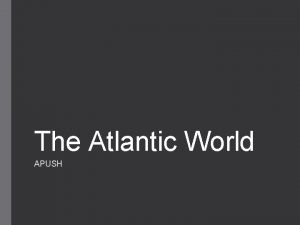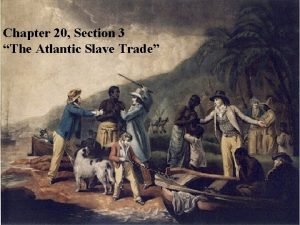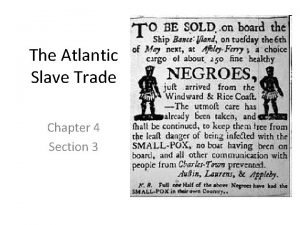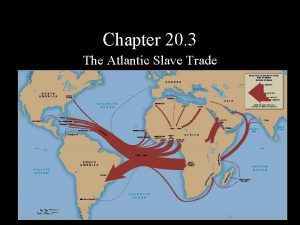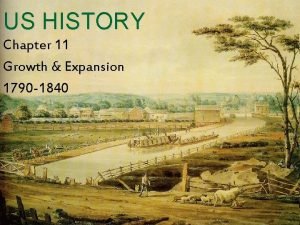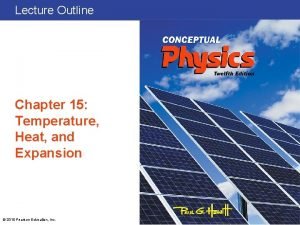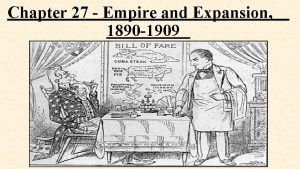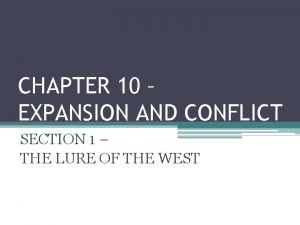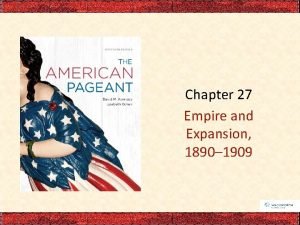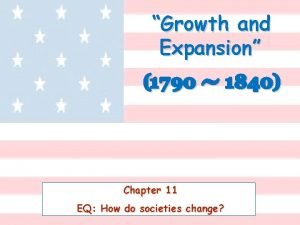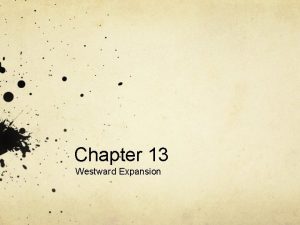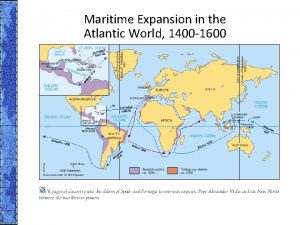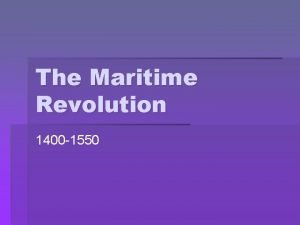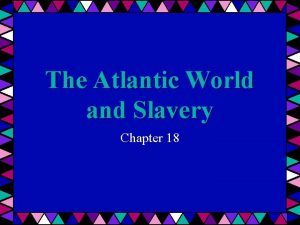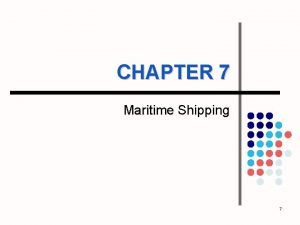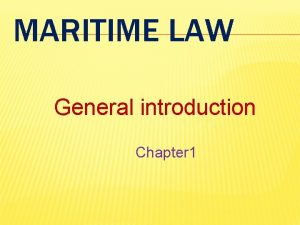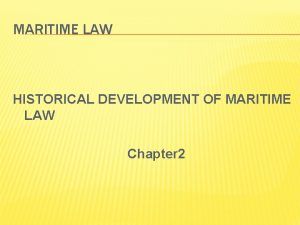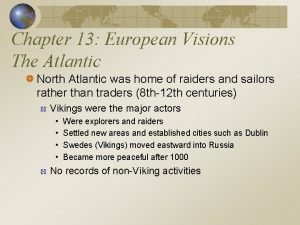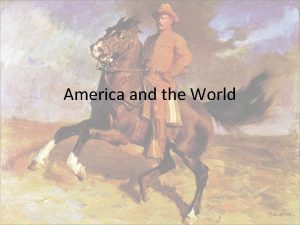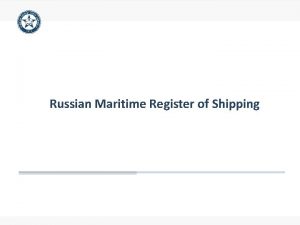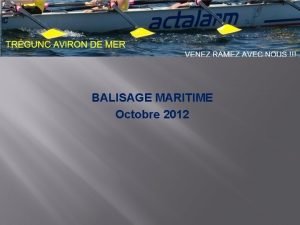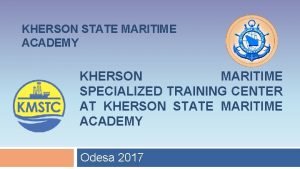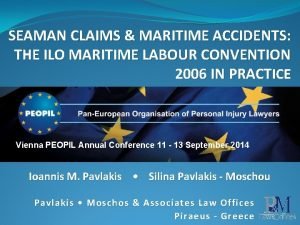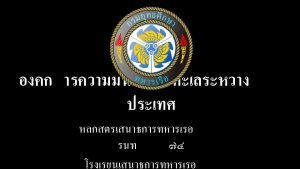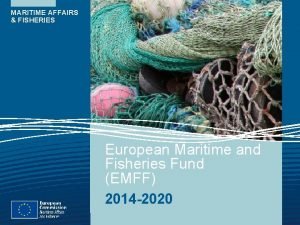Chapter 15 Maritime Expansion in the Atlantic World
































































- Slides: 64

Chapter 15 Maritime Expansion in the Atlantic World, 1400– 1600 Copyright © 2017 Cengage Learning. All Rights Reserved.

Learning Objectives (Slide 1 of 3) ▪ ▪ Describe the Aztec and Inca peoples and explain how they formed and maintained their empires Discuss how the Aztec and Inca societies were organized, their various social classes and religious practices, and the strengths and weaknesses of both societies Copyright © 2017 Cengage Learning. All Rights Reserved.

Learning Objectives (Slide 2 of 3) ▪ ▪ ▪ Discuss how the Inca treated conquered peoples Define humanist scholarship and how it encouraged oceanic exploration Explain how the invention of movable type by Gutenberg changed how Europeans viewed texts and what this meant for humanism Copyright © 2017 Cengage Learning. All Rights Reserved.

Learning Objectives (Slide 3 of 3) ▪ ▪ Identify the motivations of the Portuguese, particularly Henry the Navigator, to explore West Africa Describe the Portuguese slave trade of the fifteenth century Summarize Columbus’s explorations and his motives for undertaking them Analyze how the Spanish and Portuguese established empires in America so quickly Copyright © 2017 Cengage Learning. All Rights Reserved.

Bernardino de Sahagún In 1529, at the age of thirty, Bernardino de Sahagún landed in Veracruz, Mexico. A Franciscan friar, Sahagún worked with a team of researchers to record the history of the Aztec peoples before the Spanish arrived in a long book entitled General History of the Things of New Spain, also known as the Florentine Codex. Copyright © 2017 Cengage Learning. All Rights Reserved.

The Travels of Bernardino de Sahagún Copyright © 2017 Cengage Learning. All Rights Reserved.

The Aztec Empire of Mexico, 1325– 1519 ▪ Around 1325, the Mexica moved into central Mexico from western Mexico ▪ Spoke a Nahuatl language and were one of the Nahua peoples ▪ ▪ Had a complex calendrical system, built large stone monuments, played a ritual ball game, and believed in many gods Aztecs were continuously at war, conquering many of the city-states in central Mexico to form the Aztec empire Copyright © 2017 Cengage Learning. All Rights Reserved.

Sahagún’s Research Method ▪ Sahagún developed a sophisticated research method to recover the pre. Spanish past ▪ Developed a long outline and questionnaires detailing topics he wanted to ask the Nahua about ▪ ▪ Conducted all his interviews in three separate cities Combined all to create the General History of the Things of New Spain Copyright © 2017 Cengage Learning. All Rights Reserved.

The Mexica Settlement of Tenochtitlan (Slide 1 of 2) ▪ Various peoples migrated to Valley of Mexico after 1200 ▪ ▪ Many shallow lakes and fertile agricultural land By 1300, over fifty city-states in central Mexico ▪ Each city-state, called an altepetl, had its own government Copyright © 2017 Cengage Learning. All Rights Reserved.

MTSAU Ep 8 7: 26 -16: 43 Aztecs The Aztec Empire, Tenochtitlan and the Coming of the Spanish

The Mexica Settlement of Tenochtitlan (Slide 2 of 2) ▪ Aztec settled in Tenochtitlan, a swampland, ca. 1325 ▪ ▪ Reclaimed large areas of land from swamps and planted flowers where possible Tenochtitlan had 200, 000 people living in 60, 000 dwellings Aztecs - Chinampas - Tenochtitlan Copyright © 2017 Cengage Learning. All Rights Reserved.

Nahua Religion ▪ Most important Nahua deity was the sungod ▪ ▪ ▪ Sun had power over all main sources of food, mostly corn, beans, and peppers Sun needed regular offerings of blood, which the Nahua called precious water Aztec worshipped Huitzilopochtli as their patron god Aztec culture alive and well in Mexico Copyright © 2017 Cengage Learning. All Rights Reserved.

Mexica Skull-Mask Worshipers used deerskin straps to tie this skull-mask around their waists in a display of fearsomeness. The mask was made by applying small fragments of turquoise, black lignite coal, and white conch to the front half of a skull. The highly polished pyrite eyes glisten in the light, and the red mollusk shell nose inlays replicate the color of flayed human tissue. The mask vividly captures the importance of human offerings to the Mexica deities. Copyright © 2017 Cengage Learning. All Rights Reserved.

Nahua Society ▪ ▪ Nahua leader was the Great Speaker; treated like a god Nahua commoners made up bulk of the population ▪ ▪ Each Nahua belonged to a big house, or clan identity Lowest class in Nahua society was slaves, original residents of the valley ▪ Common people and slaves did all agricultural work Copyright © 2017 Cengage Learning. All Rights Reserved.

The Military and the Conquests of the Mexica (Slide 1 of 2) ▪ Aztec society privileged its warriors ▪ ▪ If successful in battle, a warrior could rise to high position in society Aztec weapons included spears, clubs, or darts made of obsidian ▪ Hand-to-hand combat was viewed as more honorable than other fighting Copyright © 2017 Cengage Learning. All Rights Reserved.

The Military and the Conquests of the Mexica (Slide 2 of 2) ▪ By 1500, Mexican had conquered 450 altepetl in modern Mexico ▪ ▪ Ruling over a subject population of 4 to 6 million Aztec empire had one weakness ▪ They conquered peoples and took tribute and sacrificial victims, but did not incorporate them into society History Specials: Coroner's Report - Aztec Sacrifice | History Copyright © 2017 Cengage Learning. All Rights Reserved. Feeding the gods: Hundreds of skulls reveal massive scale of human sacrifice in Aztec capital

The Aztec Empire Copyright © 2017 Cengage Learning. All Rights Reserved.

The Inca Empire, 1400– 1532 ▪ Inca empire differed significantly from the Aztec ▪ ▪ ▪ Integrated conquered peoples into society Worshipped deities that required human sacrifice Did not have an orderly system of succession 5: 46 The rise and fall of the Inca Empire Gordon Mc. Ewan Copyright © 2017 Cengage Learning. All Rights Reserved. TED-Ed

Inca Religion and Andean Society (Slide 1 of 2) ▪ ▪ Ordinary Inca organized into ayllu, which were kin groups Above the local spirits were three main gods: ▪ ▪ Creator’s child, the Sun Thunder Sapa Inca, ruler of the Inca, believed himself to be a descendant of the Sun Copyright © 2017 Cengage Learning. All Rights Reserved.

Inca Religion and Andean Society (Slide 2 of 2) ▪ The Sapa Inca and the Sun priest were part of the aristocratic class ▪ ▪ Ancestry was traced through father’s lineage, but ruler married from his mother’s lineage Mummified bodies of deceased rulers and other high-ranking family members Copyright © 2017 Cengage Learning. All Rights Reserved.

The Marvels of Incan Engineering at Machu Picchu Road to Machu Picchu - Peru in 4 K Machu Picchu 101 | National Geographic The settlement at Machu Picchu, which stands 8, 000 feet (2, 400 m) above sea level, embodies the Incan talent for engineering in its even stone houses arrayed on multiple levels, connected by manmade waterways and more than one hundred stairways. Today it is one of the world’s most visited sites and the most famous of all the Inca ruins. Copyright © 2017 Cengage Learning. All Rights Reserved.

The Inca Expansion (Slide 1 of 2) ▪ Inca settled the area around Cuzco ca. 1400 ▪ ▪ First great Inca ruler was Pachakuti, who, in 1458, seized the title of king from his brother Inca conquered neighboring lands in search of goods: herds of llama and alpaca, crops, gold, shells, and minerals Copyright © 2017 Cengage Learning. All Rights Reserved.

MTSAU Ep 5 34: 39 -44: 09 Inca

The Inca Expansion (Slide 2 of 2) ▪ Inca knew how to extract and process metal ore and made bronze ▪ ▪ ▪ Bronze largely limited to club heads and decorative objects Inca army could be as large as 100, 000 men in a single battle Legacy of Inca empire was its road system Incan Road System Copyright © 2017 Cengage Learning. All Rights Reserved.

The Inca Empire Copyright © 2017 Cengage Learning. All Rights Reserved.

Inca Rule of Subject Populations (Slide 1 of 3) ▪ Once conquered, Inca incorporated peoples into their empire and annexed their land ▪ ▪ ▪ Inca forcibly resettled many conquered peoples Images of conquered peoples’ deities were held hostage at Cuzco, so they would not rebel Inca officials counted population yearly, with a system of knotted strings, called quipu Copyright © 2017 Cengage Learning. All Rights Reserved. Threads That Speak: How The Inca Used Strings to Communicate | National Geographic

Inca Rule of Subject Populations (Slide 2 of 3) ▪ Inca did allow conquered people a great deal of autonomy ▪ ▪ ▪ Conquered people had to swear allegiance to the Inca ruler Granted the Inca ruler rights to their lands Conquered people also had to perform labor as service to the Inca state Copyright © 2017 Cengage Learning. All Rights Reserved.

Inca Rule of Subject Populations (Slide 3 of 3) ▪ Main tax of the Inca was service to state by male head of a household ▪ ▪ ▪ Two to three months of labor per year Inca also looked down on some conquered peoples and did not fully incorporate them into Incan empire Each household in the Incan state was supposed to give certain goods ▪ Examples: Textiles, tools, or food Copyright © 2017 Cengage Learning. All Rights Reserved.

Keeping Records with Knots The Inca kept all their records by using knotted strings, called quipu, attaching subsidiary cords, sometimes in several tiers, to a main cord. Different types of knots represented different numeric units; skipped knots indicated a zero; the color of the string indicated the item being counted. Copyright © 2017 Cengage Learning. All Rights Reserved.

Intellectual and Geographic Exploration in Europe, 1300– 1500 ▪ The rise of humanism ▪ ▪ Goal of scholasticism was to reconcile many differences among ancient authorities to form a logical system of thought 1350: In Italy, a new intellectual movement was created in opposition to scholasticism ▪ Humanism emphasized making people moral and good Copyright © 2017 Cengage Learning. All Rights Reserved. What Was Humanism? AP Euro Bit by Bit #2

The Rise of Humanism ▪ ▪ ▪ Petrarch (1304– 1374) was one of earliest humanist writers Cassandra Fedele (1465– 1558) gave a speech in 1487 at the University of Padua explaining her version of humanism Historians call this period of humanist revival the Renaissance, which means “rebirth” The Renaissance: Was it a Thing? - Crash Course World History #22 Copyright © 2017 Cengage Learning. All Rights Reserved.

The Art of Humanism Just as Abraham is about to sacrifice the naked Isaac, the angel of God appears and stops him. The painter Mariotto Albertinelli painted this scene on a thin piece of walnut wood, most likely intended as decoration for a cabinet. The story of Abraham’s averted sacrifice, immensely popular throughout Europe, was also the subject of a play written by Spanish missionaries in Mexico that taught the evils of human sacrifice. Copyright © 2017 Cengage Learning. All Rights Reserved.

Europe’s First Movable Type ▪ Johannes Gutenberg printed the first European book, a Bible, using movable type before 1454 ▪ ▪ Chinese had already invented movable type by the eleventh century Movable type was very suitable for European languages, which are alphabetic ▪ Printing made books popular, particularly travel narratives like the account of Marco Polo Copyright © 2017 Cengage Learning. All Rights Reserved.

MTSAU Ep 5 28: 58 -30: 36 Printing Press Gutenberg Printing Press

Early European Exploration in the Mediterranean and the Atlantic, 1350– 1440 (Slide 1 of 2) ▪ By 1350, Europeans had begun to sail past the Straits of Gibraltar into the Atlantic Ocean ▪ ▪ Two Italian explorers published a book in 1350 describing Canary Islands and their non. Christian inhabitants Natives of Canary Islands were captured and sold at slave markets Introducing the Canary Islands Copyright © 2017 Cengage Learning. All Rights Reserved.

Early European Exploration in the Mediterranean and the Atlantic, 1350– 1440 (Slide 2 of 2) ▪ In 1415, Prince Henry the Navigator of Portugal captured Moroccan city of Ceuta ▪ ▪ ▪ His goal was to convert Moroccans to Christianity Henry failed to take Canary Islands in 1424 In 1454, Portuguese occupied the island of Madeira Portugal's Prince Henry "The Navigator" Copyright © 2017 Cengage Learning. All Rights Reserved.

The Age of Maritime Expansion, 1400– 1600 Copyright © 2017 Cengage Learning. All Rights Reserved.

The Portuguese Slave Trade After 1444 ▪ Portuguese transported slaves from west coast of Africa to be sold in Europe ▪ ▪ Europeans saw slavery as a Christian act Portuguese slave traders made agreements with two Senegal rulers ▪ ▪ Horses for slaves Most African slaves worked on sugar plantations in either Canary Islands or Madeira Copyright © 2017 Cengage Learning. All Rights Reserved.

MTSAU Ep 7 31: 31 -37: 23 Slave Trade

The Varied Lives of African Migrants to Venice Completed in the early 1490 s, this painting by Vittore Carpaccio shows hunters shooting birds on a lagoon. Note the presence of African gondoliers (for example, the man in the right foreground). These men, most likely skilled rowers in their homeland, continued the same profession after their arrival in Europe. Copyright © 2017 Cengage Learning. All Rights Reserved.

The Iberian Conquest of Mexico, Peru, and Brazil, 1492– 1580 ▪ Christopher Columbus’s landfall in the Caribbean ▪ Immediate and long-lasting consequences ▪ Spanish and Portuguese quickly conquered most of Mexico and Latin America Copyright © 2017 Cengage Learning. All Rights Reserved.

MTSAU Ep 6 30: 52 -44: 13 Columbus

Columbus’s First Voyage to the Americas, 1492 ▪ Ferdinand Isabella of Spain decided to fund Columbus’ voyage to the Indies in 1492 ▪ Columbus sailed from Granada, Spain, on August 3, 1492 and arrived in Bahamas in October ▪ ▪ ▪ Islanders spoke Arawak Columbus exchanged gifts with natives Columbus believed he had sailed to Japan Copyright © 2017 Cengage Learning. All Rights Reserved.

Griot B - Found First? (Christopher Columbus)

A Comparison of Columbus’s and Zheng He’s Voyages ▪ ▪ China was richer than Spain or Portugal and thus lacked motivation to seek new lands Columbus and other European explorers were deliberately seeking new lands to colonize Copyright © 2017 Cengage Learning. All Rights Reserved.

Comparison of Columbus’s and Zheng He’s Fleets Ships Distance Traveled Length of Ships Columbus’s ships 4, 000 mi (6, 400 km) Zheng He’s ships 7, 000 mi (11, 000 km) Size of Crew Number of Voyages 80– 120 ft (24 3 – 37 m) 87 4 200 ft (61 m) 28, 000 7 Copyright © 2017 Cengage Learning. All Rights Reserved. Number of Ships 317

Comparing Zheng He’s and Columbus’s Ships (Slide 1 of 2) The full fleet of 317 Chinese treasure ships, led by Admiral Zheng He, carried 28, 000 men; the doctors on board outnumbered Columbus’s entire crew. The Chinese ships were technologically more advanced, too. The ships had watertight compartments that could contain a leak. Copyright © 2017 Cengage Learning. All Rights Reserved.

Comparing Zheng He’s and Columbus’s Ships (Slide 2 of 2) If Columbus’s sailors could not plug a leak, the entire ship would fill with water and sink. The Chinese sailors feasted on fresh fish that thrived in their watertight compartments, while Columbus’s men had to make do with hardtack, or dried biscuits. Copyright © 2017 Cengage Learning. All Rights Reserved.

The First Map to Show the Americas In 1507, a German mapmaker named Martin Waldseemüller published one hundred copies of this printed map of the world, in twelve sections, each measuring 18 by 24. 5 inches (46 by 62 cm). This map depicts the Americas as a continent separate from Asia, a fact Columbus never realized. Waldseemüller named the new landmass “America, ” for Amerigo Vespucci, a navigator whose writings deeply influenced the mapmaker. Copyright © 2017 Cengage Learning. All Rights Reserved.

Spanish Exploration After Columbus’s First Voyage, 1493– 1517 (Slide 1 of 2) ▪ Columbus did not have control over ships that accompanied him ▪ ▪ ▪ Santa Maria ran aground and was used to build a fort Niña left the fleet to seek gold With new landmass discovered, Spanish and Portuguese agreed to Treaty of Tordesillas, 1494 Copyright © 2017 Cengage Learning. All Rights Reserved.

Treaty of Tordesillas

Spanish Exploration After Columbus’s First Voyage, 1493– 1517 (Slide 2 of 2) ▪ New places discovered ▪ ▪ Cuba and Yucatan peninsula in 1508– 1509 Florida in 1510 Balboa crossed Panama and found Pacific in 1513 Magellan circumnavigated the globe in 1522 Almanac: Pacific Ocean discovered Copyright © 2017 Cengage Learning. All Rights Reserved. How Magellan circumnavigated the globe Ewandro Magalhaes

The Conquest of Mexico, 1517– 1540 (Slide 1 of 2) Hernán Cortés - Explorer | Mini Bio | BIO ▪ Hernán Cortés, a conquistador, led the conquest of Mexico ▪ Cortés landed in Yucatan in 1519 ▪ ▪ Cortés was given a Nahua noblewoman named Malinche as a gift Conquest chronicled by both Spanish and Aztec side of Mexico ▪ ▪ Bernal Díaz del Castillo, one of Cortés’s foot soldiers, wrote a detailed account Franciscan missionary Sahagún recorded Nahua accounts Copyright © 2017 Cengage Learning. All Rights Reserved.

Cortés’s Interpreter, Malinche Hernán Cortés & La Malinche (Carlos, rey emperador) This image, created by a local artist, dates to the 1500 s and shows what Cortés’s army looked like when it first landed in Mexico. The Spaniards contrast sharply with the local peoples. Malinche stands at the far right with the bearded Cortés on her left. Copyright © 2017 Cengage Learning. All Rights Reserved.

The Conquest of Mexico, 1517– 1540 (Slide 2 of 2) ▪ At first, Aztec allowed Spanish into Tenochtitlan ▪ ▪ ▪ Spanish killed last Great Speaker Moctezuma and began to massacre the Aztec Native peoples were devastated by smallpox and other diseases Aztec were finally defeated by Spanish after eighty days of fighting Copyright © 2017 Cengage Learning. All Rights Reserved.

MTSAU Ep 8 37: 11 -44

The Spanish Conquest of Peru, 1532– 1550 (Slide 1 of 2) ▪ Smallpox reached the Inca before the Spanish ▪ ▪ ▪ In 1528, Sapa Inca died of smallpox When Spanish arrived in 1532, Inca were still in midst of fighting over the throne Spanish forces, led by Francisco Pizarro, took advantage of Incan instability Francisco Pizarro: Spanish Conquistador Fast Facts | History Copyright © 2017 Cengage Learning. All Rights Reserved.

The Spanish Conquest of Peru, 1532– 1550 (Slide 2 of 2) ▪ Atahualpa was new Sapa Inca, but had not defeated his rivals completely ▪ ▪ Atahualpa received Spanish peacefully in his city of Cajamarca but Spanish attacked on second day It took twenty years for Spanish to completely subdue the Inca Conquest of the Inca Copyright © 2017 Cengage Learning. All Rights Reserved.

The Portuguese Settlement of Brazil, 1500– 1580 ▪ Portuguese reached Brazil in 1500, led by Pedro Álvares Cabral ▪ ▪ ▪ Portuguese claimed Brazil, but did not settle it In 1533, Brazil was divided into fifteen areas given to nobles Portuguese looked for gold in Brazil, but found little ▪ Portuguese built sugar plantations Copyright © 2017 Cengage Learning. All Rights Reserved. BRAZIL 2018 (with 4 K drone footage)

The Structure of Empire and the Encomienda System ▪ Economic structure of the colonies was called the encomienda system ▪ ▪ ▪ System was established in 1503 by the Spanish Monarchs “entrusted” a number of Amerindians to European settlers for labor, gold, and other goods in exchange for teaching them about Christianity Social structure of the colonies favored those born in Europe Copyright © 2017 Cengage Learning. All Rights Reserved.

The Columbian Exchange (Slide 1 of 2) ▪ Columbian exchange refers to all plants, animals, goods, and diseases that crossed the Atlantic between Americas and Europe ▪ ▪ Smallpox had the most devastating effect on the Americas Columbus also introduced plants and animals into Americas ▪ First European animal to succeed in the Americas was the pig Copyright © 2017 Cengage Learning. All Rights Reserved.

The Columbian Exchange (Slide 2 of 2) ▪ ▪ ▪ It is probable that syphilis traveled from the Americas to Europe Spanish were very successful at introducing cattle to grasslands of the Americas American food crops were introduced to West Africa ▪ Climate was very similar to Latin America Copyright © 2017 Cengage Learning. All Rights Reserved.

The Columbian Exchange: Crash Course World History #23

Chapter Timeline EVENT Mexico and Caribbean: Aztec settle Tenochtitlan APPROXIMATE DATE(S) (CE) 1, 325 Conquest and Exchange: Portugal settles Azores 1, 350 For Comparison: Ming dynasty South America: Inca settle Cuzco Mexico and Caribbean: Aztec Empire Mexico and Caribbean: Triple Alliance South America: Inca Empire Conquest and Exchange: Portugal beings Atlantic slave trade 1, 368 to 1, 644 1, 400 1, 428 to beyond 1, 521 1, 428 1, 438 to 1, 532 1, 444 Mexico and Caribbean: Lifetime of Christopher Columbus 1, 451 to 1, 506 Conquest and Exchange: Gutenberg Bible printed Before 1, 454 Conquest and Exchange: Columbus reaches Hispaniola 1, 492 Conquest and Exchange: Columbus brings European plans and animals to America For Comparison: Vasco de Gama sails are Africa to reach India 1, 493 South America: Cabral reaches Brazil For Comparison: Protestant Reformation beings 1, 500 1, 517 Conquest and Exchange: First smallpox in America 1, 518 Conquest and Exchange: Conquest of Aztec Mexico and Caribbean: Viceroyalty of New Spain 1, 519 to 1, 521 to beyond 1, 600 Conquest and Exchange: Conquest of Inca South America: Portuguese organize settlement of Brazil 1, 532 to 1, 550 1, 533 South America: Viceroyalty of Peru For Comparison: Akbar rules Mughal India 1, 543 to beyond 1, 600 1, 556 to 1, 605 Copyright © 2017 Cengage Learning. All Rights Reserved. 1, 497
 Ap world history chapter 25 africa and the atlantic world
Ap world history chapter 25 africa and the atlantic world Maritime expansion
Maritime expansion Chapter 21 revolutionary changes in the atlantic world
Chapter 21 revolutionary changes in the atlantic world World maritime technology conference
World maritime technology conference The world before the opening of the atlantic
The world before the opening of the atlantic Revolutions and national states in the atlantic world
Revolutions and national states in the atlantic world Bacons rebellion apush
Bacons rebellion apush Chapter 20 section 3 the atlantic slave trade answer key
Chapter 20 section 3 the atlantic slave trade answer key Atlantic revolutions global echoes
Atlantic revolutions global echoes Chapter 4 section 3 the atlantic slave trade
Chapter 4 section 3 the atlantic slave trade Chapter 20 section 3 the atlantic slave trade
Chapter 20 section 3 the atlantic slave trade Atlantic revolutions and their echoes
Atlantic revolutions and their echoes Chapter 21 temperature heat and expansion answer key
Chapter 21 temperature heat and expansion answer key Chapter 15 temperature heat and expansion
Chapter 15 temperature heat and expansion Chapter 11 growth and expansion
Chapter 11 growth and expansion Chapter 21 temperature, heat and expansion answer key
Chapter 21 temperature, heat and expansion answer key Algeciras conference apush
Algeciras conference apush Chapter 10 expansion and conflict worksheet answers
Chapter 10 expansion and conflict worksheet answers Microscopic slush in water tends
Microscopic slush in water tends Chapter 12 territorial and economic expansion
Chapter 12 territorial and economic expansion Chapter 27 empire and expansion
Chapter 27 empire and expansion Chapter 21 temperature heat and expansion
Chapter 21 temperature heat and expansion Chapter 21 temperature heat and expansion
Chapter 21 temperature heat and expansion Chapter 11 growth and expansion vocabulary
Chapter 11 growth and expansion vocabulary Chapter 13 westward expansion
Chapter 13 westward expansion Hát kết hợp bộ gõ cơ thể
Hát kết hợp bộ gõ cơ thể Slidetodoc
Slidetodoc Bổ thể
Bổ thể Tỉ lệ cơ thể trẻ em
Tỉ lệ cơ thể trẻ em Gấu đi như thế nào
Gấu đi như thế nào Thang điểm glasgow
Thang điểm glasgow Chúa sống lại
Chúa sống lại Các môn thể thao bắt đầu bằng tiếng đua
Các môn thể thao bắt đầu bằng tiếng đua Thế nào là hệ số cao nhất
Thế nào là hệ số cao nhất Các châu lục và đại dương trên thế giới
Các châu lục và đại dương trên thế giới Công thức tính thế năng
Công thức tính thế năng Trời xanh đây là của chúng ta thể thơ
Trời xanh đây là của chúng ta thể thơ Mật thư anh em như thể tay chân
Mật thư anh em như thể tay chân Phép trừ bù
Phép trừ bù Phản ứng thế ankan
Phản ứng thế ankan Các châu lục và đại dương trên thế giới
Các châu lục và đại dương trên thế giới Thơ thất ngôn tứ tuyệt đường luật
Thơ thất ngôn tứ tuyệt đường luật Quá trình desamine hóa có thể tạo ra
Quá trình desamine hóa có thể tạo ra Một số thể thơ truyền thống
Một số thể thơ truyền thống Cái miệng nó xinh thế chỉ nói điều hay thôi
Cái miệng nó xinh thế chỉ nói điều hay thôi Vẽ hình chiếu vuông góc của vật thể sau
Vẽ hình chiếu vuông góc của vật thể sau Thế nào là sự mỏi cơ
Thế nào là sự mỏi cơ đặc điểm cơ thể của người tối cổ
đặc điểm cơ thể của người tối cổ V cc
V cc Vẽ hình chiếu đứng bằng cạnh của vật thể
Vẽ hình chiếu đứng bằng cạnh của vật thể Fecboak
Fecboak Thẻ vin
Thẻ vin đại từ thay thế
đại từ thay thế điện thế nghỉ
điện thế nghỉ Tư thế ngồi viết
Tư thế ngồi viết Diễn thế sinh thái là
Diễn thế sinh thái là Các loại đột biến cấu trúc nhiễm sắc thể
Các loại đột biến cấu trúc nhiễm sắc thể Bảng số nguyên tố lớn hơn 1000
Bảng số nguyên tố lớn hơn 1000 Tư thế ngồi viết
Tư thế ngồi viết Lời thề hippocrates
Lời thề hippocrates Thiếu nhi thế giới liên hoan
Thiếu nhi thế giới liên hoan ưu thế lai là gì
ưu thế lai là gì Khi nào hổ mẹ dạy hổ con săn mồi
Khi nào hổ mẹ dạy hổ con săn mồi Khi nào hổ con có thể sống độc lập
Khi nào hổ con có thể sống độc lập Sơ đồ cơ thể người
Sơ đồ cơ thể người

